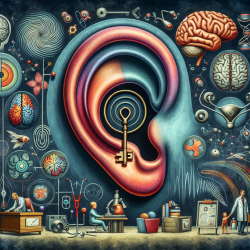Introduction
In the ever-evolving field of special education and clinical therapy, staying informed about the latest research and technologies is crucial. One such groundbreaking tool is Magnetoencephalography (MEG), a non-invasive technique that provides a direct view of neural activity with millisecond temporal precision. Recent advancements in MEG analysis offer promising insights into auditory processing disorders, particularly Central Auditory Processing Disorder ((C)APD), which often manifests in children as difficulty hearing in noisy environments despite normal hearing thresholds.
The Power of MEG in Understanding Auditory Function
MEG has been utilized for over three decades to enhance our understanding of auditory processing. By combining MEG with inverse imaging methods and functional connectivity measures, practitioners can gain a deeper understanding of cortical processing. These techniques allow for precise mapping of neural activity, providing insights into how the brain processes auditory information.
For practitioners, this means the potential to improve diagnostic accuracy and develop targeted intervention strategies for (C)APD and other auditory disorders. By integrating MEG with auditory paradigms, clinicians can explore the neural underpinnings of auditory dysfunction and evaluate the effectiveness of various treatments.
Implementing MEG in Clinical Practice
Practitioners can leverage MEG in several ways to enhance their clinical practice:
- Improved Diagnosis: MEG provides a detailed view of neural activity, enabling more accurate diagnosis of (C)APD by identifying specific cortical dysfunctions.
- Targeted Interventions: By understanding the neural basis of auditory processing disorders, practitioners can develop and implement targeted intervention strategies that address the root causes of dysfunction.
- Evaluation of Treatment Efficacy: MEG allows for the assessment of neural changes following interventions, providing valuable feedback on the effectiveness of therapeutic approaches.
Encouraging Further Research
While MEG offers significant potential, further research is needed to fully realize its capabilities in clinical settings. Practitioners are encouraged to engage in collaborative research efforts, attend conferences, and participate in webinars to stay updated on the latest developments in MEG technology and its applications.
By fostering a culture of continuous learning and collaboration, the special education and clinical therapy community can unlock new possibilities for understanding and treating auditory processing disorders.
Conclusion
Magnetoencephalography (MEG) stands as a beacon of hope in the quest to understand and address auditory processing disorders. By embracing this technology and integrating it into clinical practice, practitioners can enhance their diagnostic and therapeutic capabilities, ultimately improving outcomes for individuals with (C)APD and other auditory dysfunctions.
To read the original research paper, please follow this link: Potential Use of MEG to Understand Abnormalities in Auditory Function in Clinical Populations.










